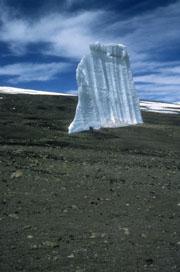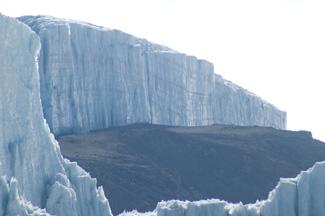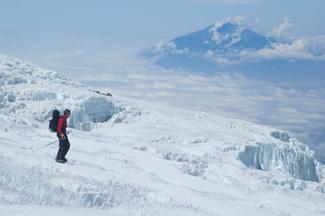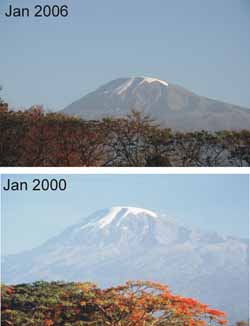 Remnant of the Eastern Ice Field as seen 2000. This particular chunk of ice has now disappeared.Lonnie G. Thompson
Remnant of the Eastern Ice Field as seen 2000. This particular chunk of ice has now disappeared.Lonnie G. ThompsonPosted on 11/06/2009 12:38:06 AM PST by neverdem
Glaciers crowning Africa's tallest mountain could disappear within decades.
 Remnant of the Eastern Ice Field as seen 2000. This particular chunk of ice has now disappeared.Lonnie G. Thompson
Remnant of the Eastern Ice Field as seen 2000. This particular chunk of ice has now disappeared.Lonnie G. ThompsonThe snows of Kilimanjaro are rapidly disappearing and will be gone by 2033, predicts the most detailed analysis yet of the iconic glaciers gracing Africa's highest peak.
In addition to shrinking in area, Kilimanjaro's glaciers are thinning from the top down, says Ohio State University's Lonnie Thompson, lead author of the new study. "They're being decapitated," he says. "In fact, they're probably not really glaciers anymore. They're remnants of another climate."
In 2000, Thompson and his team made the first modern measurements of Kilimanjaro's ice. Thompson drilled cores from the three glaciers ringing the summit, estimating that the ice bodies date back at least 11,700 years. The team then anchored stakes in bedrock at the bottom of the drill holes and have since used the stakes to measure the thickness of the ice.
One of the small summit glaciers, called the Furtwängler, lost about half its thickness — nearly five meters — between February 2000 and February 2009. At that rate, the 4.6-meter-thick Furtwängler will be gone in another decade, Thompson estimates. Other glaciers on Kilimanjaro will survive longer, but they too will disappear between 2022 and 2033, Thompson's latest estimates suggest. A second summit glacier, the southern ice field, thinned 24% between 2000 and 2007.
Thinning accounts for about half of the ice loss on the mountain, says Thompson, with retreat of the ice from the glaciers' edges accounting for the other half.
Since 1912, when aerial photographers documented Kilimanjaro's glaciers, the mountain's ice fields have shrunk around 85% in area, decreasing from 12 square kilometres in size to just 1.85 square kilometres. That pace seems to be accelerating, as the glaciers shrunk 26% in area between 2000 and 2007. Thompson and colleagues calculated the glaciers' coverage with aerial and satellite images, confirming their retreat with the stakes the researchers began placing around the glaciers in 2000.
 The Northern Ice Field margin still rises to heights of around 30 meters.Douglas Hardy, UMass Geosciences
The Northern Ice Field margin still rises to heights of around 30 meters.Douglas Hardy, UMass GeosciencesMelting and sublimation both contribute to the ice loss, says study author Doug Hardy, a glaciologist from the University of Massachusetts at Amherst. The glaciers have been in retreat for more than a century, Hardy says, with a drying climate in East Africa one main culprit.
"The top [of the mountain] is very, very dry. It's a desert up there," Hardy says. The lack of new snowfall means the dark, dirty tops of glaciers absorb more solar radiation than they otherwise would. In addition, the nearby Indian Ocean has warmed, says Hardy, altering circulation patterns that used to bring more moisture to the mountain. But Hardy says there is too little data to blame the ice loss on increasing atmospheric temperatures. "It's entirely reasonable that, yes, the glaciers are going away on Kilimanjaro in response to global warming," but the link is via Indian Ocean-driven circulation patterns rather than via a warmer atmosphere, says Hardy. The study is published in Proceedings of the National Academy of Sciences of the USA1.
Chris Larsen, a glaciologist at the University of Alaska-Fairbanks, called tropical glaciers like those on Kilimanjaro the "drama queens" of the glacier world: they respond dramatically to even slight insults. "When the climate changes, they can portray a bad situation in even worse light," says Larsen. "The fact that these ice fields are now on the verge of ending a 11,000 year existence is quite significant."
 Kilimanjaro's glaciers seem to be shrinking at an ever-faster rate.Douglas Hardy, UMass Geosciences
Kilimanjaro's glaciers seem to be shrinking at an ever-faster rate.Douglas Hardy, UMass GeosciencesAs other data from Thompson and colleagues confirms, the much larger tropical ice fields of the Andes Mountains are also shrinking, which within decades will leave tens of millions of people without drinking water. In contrast, the relatively small glaciers on Kilimanjaro provide little water for local residents.
However, the Kilimanjaro glaciers do attract some 25,000 visitors each year, a major revenue source for Tanzania. Hardy, who's made 12 trips up the mountain since 2000, says he's noticed the crowds of summiteers growing larger; he thinks the stampede began in response to the global attention the shrinking glaciers received in 2002, when he and Thompson published their first paper on the subject2.
"The mountain is famous because of its ice fields at the Equator," says Thompson, who added that tourism may dry up when the glaciers do. "Hemingway knew that a long time ago."
Heresy! Burn him at the stake!
If glaciers didn’t melt lots of Canada and the US would be an ice field now. No man made global warming then and none now.
Gosh, I really miss a couple of miles of ice over northern north America... Oh what will we do now that they’re gone... Oh the pain...
That is what is so ominous. Look at what happened to lower New York when the glaciers retreated. Stockbrokers and bankers moved in.
This is recycled information, due entirely to weather patterns. In 2007-8 the snow came back. In 2009 it is dry again. Here's the article from earlier this year with the misleading comparison (2000-2006):
http://www.physorg.com/news10862.html
and the picture from the article:

And a current picture of the mountain (early 2009): 
Don’t you know the rules? Choose an arbitrary point in time when people were able to take photographs, then announce that this is the way the world must stay - FOREVER.
+1 if Hemingway has written a story with the name of the place in the title. It helps you feel all broody and noble.
“Glaciers crowning Africa’s tallest mountain could disappear within decades.”
SO WHAT?

While currently some glaciers are retreating there are others which are thickening. That is historically consistent ... good grief, the earth has seen Ice Ages retreat long before there were SUVs.

Consider the research of Ohio State University glaciologist Lonnie Thompson ... he who predicted in a 10/02 paper in Science an end to Kilimanjaro's glaciers by 2020, more or less, according to current trends. I remember when ABC news picked this up.
Well. much of modern environmental journalism displays a pervasive lack of critical insight toward environmental scares and the scientific papers on which they are supposedly based. An inspection of Thompson's own data, also published in i Science, shows that Kilimanjaro's glaciers would be dying even if i Homo sapiens ancestors were still the dominant hominid in the Rift Valley, a few hundred miles to the West. That is to say, humans are not to blame for the glacial recession.
Thonpson cited five surveys of Kilimanjaro from 1912, 1953, 1976, 1989, and 2000, as per your graphic.
From 1912 to 1953, global temperatures rose (as measured controversially by surface thermometers) 0.4° C (0.74° F). This rise occurred before most of the industrial emissions of so-called "greenhouse gases" , mainly CO2 and CH4. As a result. most scientists think the warming of the 20th century had mainly to do with changes in Mr. Sun. In fact, slight changes in solar output have modulated the earth's surface temperature plus or minus about 1.0° C (1.8° F) over millennia.
Kilimanjaro's glaciers lost 45% of their areal extent during that era of solar warming. If the glaciers had continued to decline at the pace established in that period, they would already be gone by now, pfffft, even with no additional warming from the emissions of greenhouse gases.
But the glaciers are still here. From 1953 through 1976, another 21 percent of the original area was uncovered. This occurred during a period of global cooling of 0.07° C (0.13° F). OSU's press office could logically have written the following hype in 1976: "Kilimanjaro's glaciers will completely disappear by 2015 if this cooling trend continues".
It is patently obvious that global temperatures and their behavior of Kilimanjaro's glaciers are pretty independent, at least on the time scale of decades. Local climate, however, is apparently critical. A glacier cares what happens from its head to its toe, not elsewhere.
The local climate record around Kilimanjaro is confusing. There is very little cohesion between nearby thermometers which argues more that the data are bad than it does for any local cooling or warming. Poor (unsubsidized by Kyoto) countries have little income to spend on a quality climate-monitoring network.
Since, 1976, another 12% of the original mass has disappeared - and despite all the hoopla, a loss of 12% represents the slowest decline since 1912. Although the local temperature measurements are clearly questionable, more recent decades' measurements area as close to perfect as possible. In 1979 satellite monitoring began. All scientists - even the most ardent Anthropogenic Global Warming ™ apocalyptics - acknowledge that the satellite is excellent at measuring temperatures at the altitude of Kilimanjaro's glaciers - about 19,000 feet. In fact, it may measure temperatures at that altitude better than it does at sea level.
Around Kilimanjaro, satellite data shows a cooling of 0.22°C (0.40°F) since 1979, which is the same as the global warming rate between 1912 and 1953 (0.09°C or 0.17°F per decade). Still, Kilimanjaro's glaciers continue to shrink.
In his Science article, Thompson noted that the period from 4,000 to 11,000 years ago was warmer in Africa than it is today, and yet Kilimanjaro was much more glaciated because it was also wetter than it is today. Some estimates place today's precipitation at only 50% of what it was during the warmer period. Obviously, precipitation, not Anthropogenic Global Warming ™ temperature, is the key to the glaciation of Kilimanjaro.
Did people make it stop snowing? Precipitation in East Africa is highly correlated with El Niño activity in the tropical Pacific ocean. During the last big one, 1997-8, how many news stories promulgated the notion that El Niños are becoming more frequent because of AGW?
So someone could argue that humans cause global warming, global warming causes more El Niños, more El Niños affect precipitation, and therefore humans are causing the glaciers to recede. But, if people are causing more El Niños, then in fact it should be snowing more and more on Kilimanjaro - more than it did back in the day when it was even warmer, thousands of years ago.
Hemmingway was a WHACK-JOB!
Four wives - rally something back then.
My spelling this morning is ‘rally’ something...
 |
||
| · join · view topics · view or post blog · bookmark · post new topic · subscribe · | ||
“Oh, the pain”
If you have read the first link in Comment #1, you will have seen the potential for very large pain. The article points out that Kilimenjaro is a poor example, but that glacial melting and disappearance is a world wide phenomena. It points out that the “stans”, China, and India are all very dependent on glacial meltwater. You think we have trouble in Pakistan now, guess what happens when they no longer have river water. The article points out that loss of glaciers would cut the Ganges River flow by 2/3, affecting 1/2 BILLION people. You can laugh, but your children and grandchildren may pay the price of war, famine, etc. I have a son in Special Forces, so I think about this. You should too.
“Oh, the pain”
If you have read the first link in Comment #1, you will have seen the potential for very large pain. The article points out that Kilimenjaro is a poor example, but that glacial melting and disappearance is a world wide phenomena. It points out that the “stans”, China, and India are all very dependent on glacial meltwater. You think we have trouble in Pakistan now, guess what happens when they no longer have river water. The article points out that loss of glaciers would cut the Ganges River flow by 2/3, affecting 1/2 BILLION people. You can laugh, but your children and grandchildren may pay the price of war, famine, etc. I have a son in Special Forces, so I think about this. You should too.

Is is melting on both peaks?
The only thing constant on this planet is change.
And what are we supposed to do about it besides preventing deforestation near glaciers? Show me the evidence that anthropogenic global warming has any validity as a plausible hypothesis, if you please. If you will check global cooling, there's plenty of evidence to the contrary.
Very bad plan to depend on melting glaciers for water for long term development.
There was a lot of melting in norther north America too. That’s long since been over.
What I laugh at is the idiot attitude that this snap shot in time is how things should be forever on. The world is a changing place non stop. The climate and has been changing since the beginning. The sun changes. Continents move. Ocean currents change.
You can’t stop the world. You adapt or die.
Disclaimer: Opinions posted on Free Republic are those of the individual posters and do not necessarily represent the opinion of Free Republic or its management. All materials posted herein are protected by copyright law and the exemption for fair use of copyrighted works.